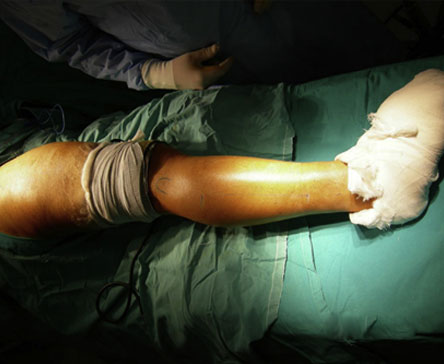Mehmet Bekir Ünal, Eren Cansu, Fatih Parmaksızoglu, Hakan Cift, Serkan Gürcan
Goztepe Medicalpark Hospital,
Istanbul, Turkey b Marmara University School of Medicine, Turkey
Yeni Yüzyıl University School of Medicine, Turkey d Istanbul Medipol Universitesi Istanbul, Istanbul, Turkey
Private Medicana Hospital, Turkey
Abstract
Objectives: The aim of this study was to determine long term follow up of the patients who had femoral head osteonecrosis and had been treated with free vascularized fibular grafting.
Patients and methods: We retrospectively reviewed 28 hips of 21 patients who had undergone free vascularized fibular grafting for the treatment of osteonecrosis of femoral head. There were 16 male and 5 female patients. The mean age of the patients at the time of surgery was 30.7 years (between 15 and 53 years). The mean follow-up time was 7.6 years (between 5 years and 9.2 years).
Results: During follow-up, one patient died because of leukemia, and one patient was lost. The remaining 26 hips of 19 patients were evaluated. According to the Ficat classification, at the time of surgery, 17 hips were in grade 2 and 9 hips were in grade 3. The post-operative Harris hip scores in grade II disease were excellent in 12 patients, good in 3 patients, and fair in 1 patient. In grade III disease, 1 patient was excellent, 5 patients were good, and 1 patient was fair. There was a significant increase in HHS scores (61 ± 9.7 vs 84 ± 17.8, p < 0.001).
Conclusion: Free vascularized fibular grafting yields extremely good results, particularly in pre-collapse stages of disease in young patients. The operation time does not mark increased if the surgical team is “familiar” with the procedure, and the residual fibular defect of the donor site does not impair the functions of daily living. Level of Evidence: Level IV, Therapeutic study.
© 2016 Publishing services by Elsevier B.V. on behalf of Turkish Association of Orthopaedics and Traumatology. This is an open access article under the CC BY-NC-ND license (http://creativecommons. org/licenses/by-nc-nd/4.0/).
Introduction
Osteonecrosis of the femoral head is a disabling disease that frequently affects adults aged 20e50 years. Whatever the etiology, the disease often progresses to femoral head collapse and hip joint arthritis if left untreated. Treatment options for the disease mainly depend upon the stage and age of the patient. According to many studies, the etiology of the disease is not a determinant for a particular technique. Older age, severely collapsed femoral head, and arthritic patients are accepted as candidates for arthroplasty. Treatment options before collapse of the femoral head aim for regeneration of the subchondral necrotic bone to prevent collapse and preserve sphericity of the femoral head. Core decompression with or without cancellous bone grafting, non-vascularized strut grafts, tantalum rods, electrode insertions, different types of osteotomies, and free or muscle pedicled viable bone grafts have been presented for this purpose. Among these techniques, core decompression with vascularized fibular grafting technique removes all necrotic bone and fills the remaining cavity with vascularized bone graft and spongious graft that contain osteoinductive and osteoconductive properties together. The procedure is not new to our knowledge, but most reports in the literature are from a small number of pioneering clinics utilizing the free vascularized fibular grafting (FVFG) technique. In this study, we presented our experience in treatment with FVFG in pre- and post-collapse stages of disease. We report medium-term (mean: 7.6 years) follow-up results.
http://dx.doi.org/10.1016/j.aott.2016.01.001
1017-995X/© 2016 Publishing services by Elsevier B.V. on behalf of Turkish Association of Orthopaedics and Traumatology. This is an open access article under the CC BY-NCND license (http://creativecommons.org/licenses/by-nc-nd/4.0/).

